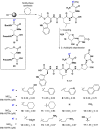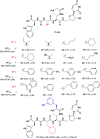Sansanmycin natural product analogues as potent and selective anti-mycobacterials that inhibit lipid I biosynthesis
- PMID: 28248311
- PMCID: PMC5337940
- DOI: 10.1038/ncomms14414
Sansanmycin natural product analogues as potent and selective anti-mycobacterials that inhibit lipid I biosynthesis
Abstract
Tuberculosis (TB) is responsible for enormous global morbidity and mortality, and current treatment regimens rely on the use of drugs that have been in use for more than 40 years. Owing to widespread resistance to these therapies, new drugs are desperately needed to control the TB disease burden. Herein, we describe the rapid synthesis of analogues of the sansanmycin uridylpeptide natural products that represent promising new TB drug leads. The compounds exhibit potent and selective inhibition of Mycobacterium tuberculosis, the etiological agent of TB, both in vitro and intracellularly. The natural product analogues are nanomolar inhibitors of Mtb phospho-MurNAc-pentapeptide translocase, the enzyme responsible for the synthesis of lipid I in mycobacteria. This work lays the foundation for the development of uridylpeptide natural product analogues as new TB drug candidates that operate through the inhibition of peptidoglycan biosynthesis.
Conflict of interest statement
The authors declare no competing financial interests.
Figures




References
-
- World Health Organization. Global Tuberculosis Report 2015, (Geneva, Switzerland (2015).
-
- Zumla A., Nahid P. & Cole S. Advances in the development of new tuberculosis drugs and treatment regimens. Nat. Rev. Drug Discov. 12, 388–404 (2013). - PubMed
-
- Gandhi N. R. et al.. Extensively drug-resistant tuberculosis as a cause of death in patients co-infected with tuberculosis and HIV in a rural area of South Africa. Lancet 368, 1575–1580 (2006). - PubMed
-
- Chahine E. B., Karaoui L. R. & Mansour H. Bedaquiline: a novel diarylquinoline for multidrug-resistant tuberculosis. Ann. Pharmacother. 48, 107–115 (2014). - PubMed
-
- Newman D. J. & Cragg G. M. Natural products as sources of new drugs over the last 25 years. J. Nat. Prod. 70, 461–477 (2007). - PubMed
Publication types
MeSH terms
Substances
Grants and funding
LinkOut - more resources
Full Text Sources
Other Literature Sources
Molecular Biology Databases

